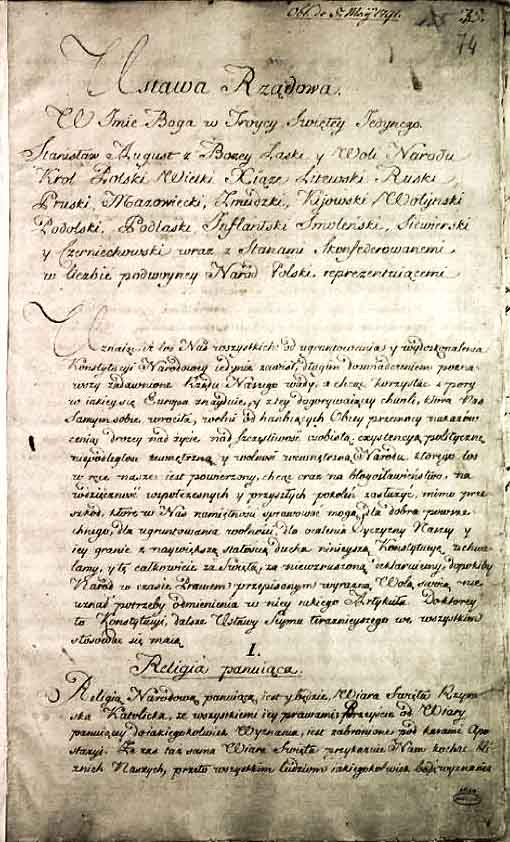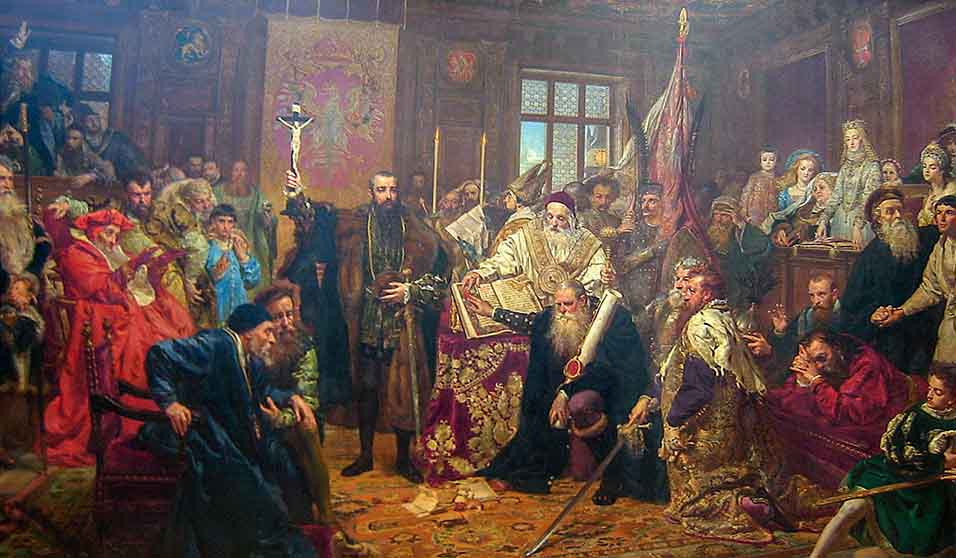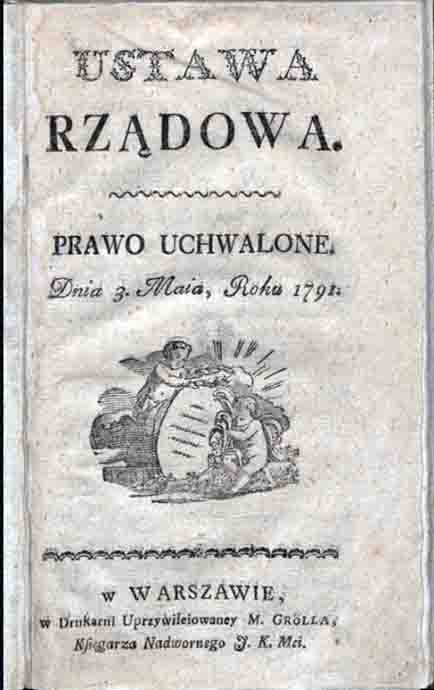The fathers of the Polish basic law, known as May Constitution, knew the American constitution and were no strangers to the names of Washington and Franklin. Europe, mainly England, France and Spain, closely watched the process of strengthening the central government in the united provinces of America. Through France, news of the principles and forms of government of the thirteen united states reached Poland, gaining, if not sympathetic recognition, then at least prudent attention. The principles of the American constitution appeared in excerpts in the press, as well as in book editions.
Although the Polish-Lithuanian Commonwealth was practically a federation of the Crown and the Grand Duchy, resembling the union of thirteen American states, the Polish authors of the Constitution abandoned the federation ideas. A great political activist, Fr. Hugo Kołłątaj, a man with great horizons of thought, although he accepted the basic principles of the American constitution, did not fully consider its premises appropriate for the Commonwealth.

The manuscript of the American Constitution of 1789 (Source: Wikipedia)
The American Constitution was not, as is commonly believed, the first in the world. It was preceded by the Corsican constitution of 1755. However, it was of great importance and influence. It was created and passed the most legal way (1787), although discussions and work on it were conducted in secret, and the participants of the deliberations undertook not to even take notes. News of the deliberations leaked to the public from Madison's writings many years later, often at a time when many of the Basic Law were already dead. However, we do not know exactly how many people worked on the text of the Polish constitution, we only know a few names.
The Polish constitution was passed through a coup d'état, the voting and swearing in of the law was accelerated due to fears of the opposition's reaction. The American constitution was passed through the most formal process. The draft was presented to the Continental Congress, which sent it to the thirteen state assemblies. The ratification of the whole was done by specially created constitutional conventions in 1788. This was followed by the election of the president of the United States, who was George Washington, the only "founding father" without a university education, but a colonel already at the age of twenty-two. It is also worth noting that he was the only incumbent US president to resign during a second term, and that is because that he did not agree with his political opponents. It seems incredible to us, people of the 21st century!
The young American state outlined the formula and boundaries of the legal activity of the government. The American Constitution is a compact document that precisely defines the structures of the federal state and the authority of individual states, as well as the division of powers. The Polish constitution covers the entire state structure in eleven chapters, and defines the privileges of individual layers of society. It talks about religion, and discusses the issue of the country's defense.

The manuscript of the Polish constitution of May 3rd 1791 (Source: Wikipedia)
The fathers of the Polish constitution took into account the existing political situation and the strengths of individual social strata. It is the Constitution of the Third May, the result of the deliberations of the Great Seym, as a clear proof of how much the leaders of the Republic of that time, with the remarkable monarch Stanisław August Poniatowski, wanted to free their country from political impotence, ignorance and superstition and add to the changing a modern Europe, shaken by changes in France and news from the New World.
Poland did not want to break the monarchical system. According to the Third May Constitution (and later also according to Article V of the Constitution of the Duchy of Warsaw), after the childless death of Poniatowski, who had no legal offspring, the hereditary throne of the Polish-Lithuanian Commonwealth was to be taken over by a Saxon elector from the Wettin family. Today it would be Alexander of Saxony-Gessaphne.
It does not mean, then, that all foreign patterns were accepted without reservations, on the contrary, a certain distance was kept, trying to imitate only what was in line with the tradition and mentality of Poles and Lithuanians. Hence, the republican assumptions were rejected, assuming that the situation and history of the Two Nations did not justify them, some English models were chosen, such as government accountability to parliament, budget control by parliament, majority voting and a constitutional monarchy with a hereditary legacy of the throne.
One thing is certain: the fathers of the American and Polish constitution aimed at the good of their fellow citizens: "Desiring to perfect the Union, to secure peace in the country, to ensure common defense, to increase general well-being and to keep the benefits of freedom for ourselves and our offspring."
The Poles wanted to save their endangered statehood "for the common good, for the consolidation of freedom, for the preservation of our homeland and its borders, with the greatest constancy of spirit".
The same thought was both in Philadelphia and in Warsaw. The activity of patriots, authors of fundamental laws in the young United States, and in the Polish-Lithuanian Commonwealth, "raised a monument to the nation's healthy instinct and sincere patriotism." Perhaps thanks to this work the American state strengthened and the Poles survived the night of partitions.
But some matters were not fully resolved by both constitutions: in the Commonwealth the Basic Law did not abolish the servitude of peasants, and in America slavery. Washington himself did not consider this state of affairs worth condemnation, he himself owned slaves whom he granted freedom in his testament, but by many historians this act of his is considered only a Christian reflex, having no major impact on the fate of the people deprived of freedom.
Despite the shortcomings of both fundamental laws, the solemn celebrations of their anniversaries are fully justified. "We need to praise this day, which put us in a pleasant situation without blood, without a shot," wrote the Polish poet two hundred years ago. These words can be applied more accurately to the American constitution — the adoption of the Polish constitution triggered reactions from Russia, a new partition, and, in the end, enslavement of over a hundred years.







